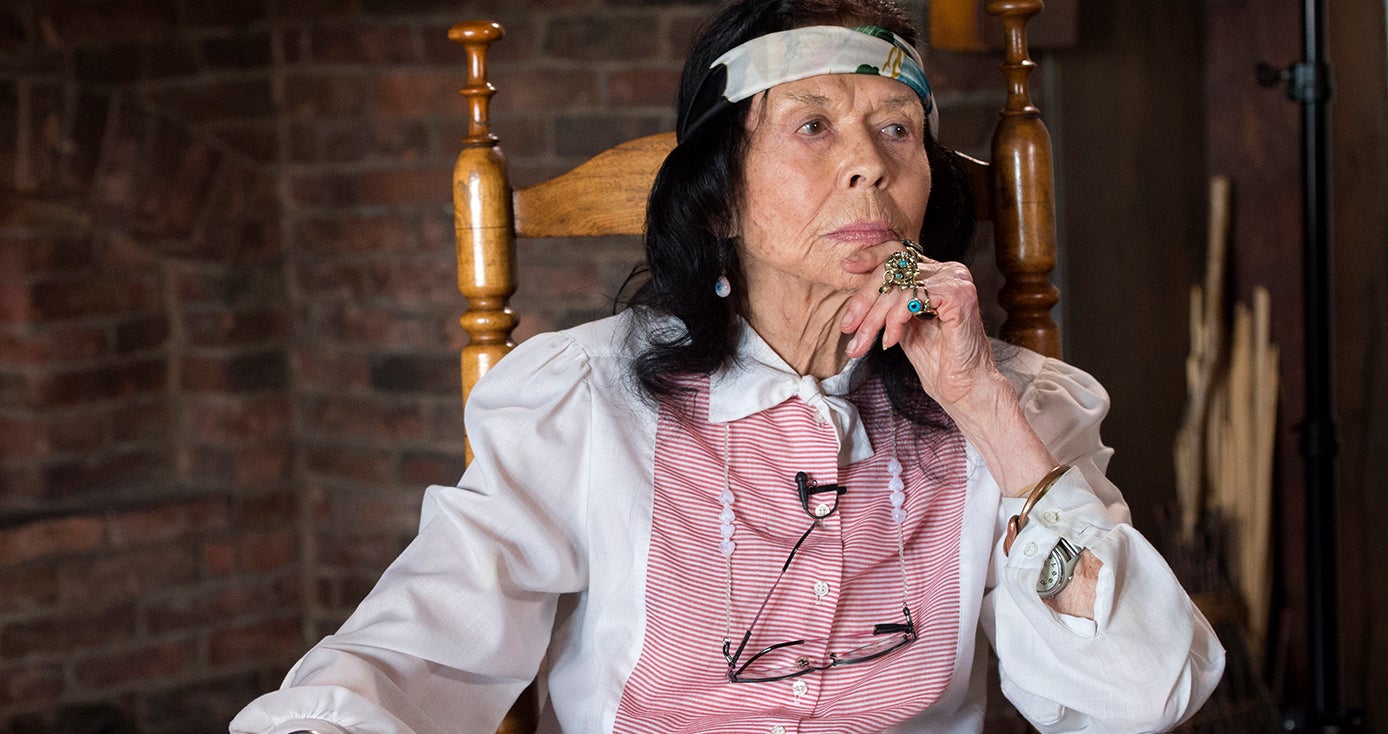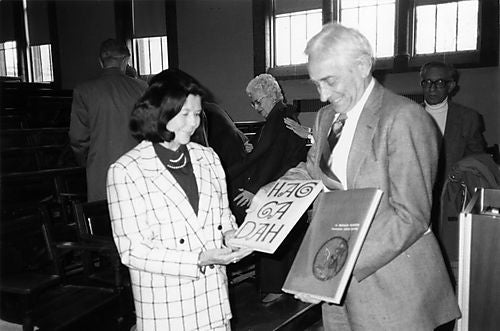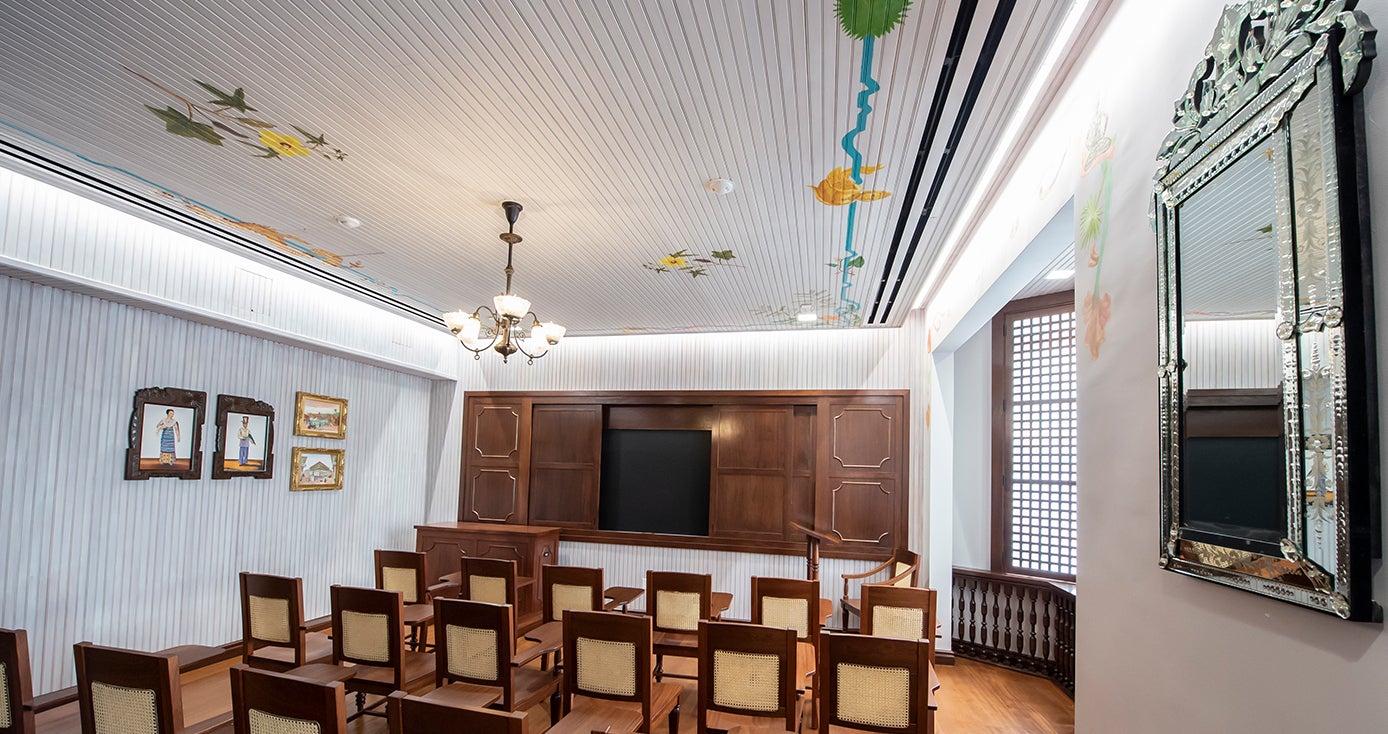
Subscribe to Pittwire Today
Get the most interesting and important stories from the University of Pittsburgh.E. Maxine Bruhns, Who Dedicated Her Career to Embracing Cultural Diversity, Dies at 96
E. Maxine Bruhns, who brought the diverse cultures and traditions of so many immigrant and refugee communities from around the world to the University of Pittsburgh for students and visitors to experience throughout the past five decades, died on July 17, 2020, in Pittsburgh at age 96.
Born in West Virginia in 1924, Bruhns was considered a “citizen of the world” at Pitt, where she served as director of the Nationality Rooms and Intercultural Exchange Programs from 1965 until her retirement in January 2020. What she called her greatest accomplishment: growing Pitt’s Nationality Rooms into a collection of 31 mini-museums that represent the immigrant populations of Pittsburgh and their contributions to the city.
“Our community is in mourning—having just learned about the loss of one of our most beloved members,” said Chancellor Patrick Gallagher. “For more than 50 years, Maxine served as director of the University of Pittsburgh’s Nationality Rooms. In this role, she became a global ambassador, academic leader and generous donor. She was as unique and striking as the rooms themselves, and—while she will be deeply missed—her incredible legacy has left an indelible mark, and her love of learning, history and culture will live on.”
“Long before diversity and inclusion became part of institutional conversations, Maxine honored—and celebrated—nationalities from around the world. She wove them into the culture at Pitt,” said Ariel C. Armony, vice provost for global affairs and director of the University Center for International Studies (UCIS), which houses the Nationality Rooms. “She was crucial in transforming the Nationality Rooms into the Pittsburgh-famous destination they are today.”
The Nationality Rooms, which line the halls of the Cathedral of Learning’s first and third floors, are collectively designated a historical landmark by the Pittsburgh History and Landmarks Foundation, and they are equally cherished by the Pitt community and visitors from around the world. All but two of the rooms also serve as classrooms.
Global experiences
Before starting her 54-year career at Pitt in the 1960s, Bruhns immersed herself in different cultures of the world with her husband, Fred C. Bruhns, who she met while studying at the Ohio State University. Fred immigrated to the United States from Germany in 1941 after serving two years in a Berlin prison for anti-Nazi activity. The two were married from 1946 until his death in 2008.
Bruhns and her husband spent 15 years living overseas, working with refugees in countries including Cambodia, Greece, Lebanon and Vietnam. While abroad, Bruhns completed her master’s degree, taught English and did humanitarian work. Fred worked with the United States Agency for International Development, eventually serving as the head of the United Nations’ High Commissioner for Refugees’ office in Athens, Greece.
Bruhns, who was born in Grafton, West Virginia, has said to have used this time to learn “not to hate,” but “always appreciate” the culture in which she was living. In addition to English, she was fluent in French and German, and she also had knowledge of Farsi, Arabic and Greek.
The Bruhns came to Pitt in 1965, where Fred earned his PhD and taught at Pitt’s Graduate School of Public and International Affairs, and Maxine accepted a job as executive secretary of the University’s cultural and educational exchange committee. In Pittsburgh, the couple resided in the Squirrel Hill neighborhood, and later, in the Fox Chapel area. They did not have children.
Growing the Nationality Rooms
The Nationality Rooms were established in 1938 after an idea from Pitt Chancellor John Gabbert Bowman to highlight immigrants’ contributions to America. Ruth Crawford Mitchell, founding director of Pitt’s Nationality Rooms and Intercultural Exchange programs, oversaw the creation of the rooms beginning in 1926, the same year that construction began on the Cathedral of Learning. Mitchell later served as Bruhns’ mentor and best friend.
In the 1960s, when Bruhns came to Pitt, there were no plans to expand on the Nationality Rooms—they were “badly neglected,” Bruhns had said. At the time, there were 19 Nationality Rooms; when Bruhns retired, there were 31.
Each room has a committee, which comprises members of the community who are in charge of fundraising, programming and room design, with the partnership of Bruhns.
“For every Nationality Room, Maxine got to know the people on the committee personally,” said Maryann Sivak, Bruhns’ former executive assistant and longtime friend. “She’d remember their birthdays. She was always the first to send a card if someone died in their family. She put this personal touch on everything she did. Everyone who requested a meeting with her could always expect to be treated to apple juice and cookies. Those are the things I admired about her.”
The first room created under Bruhns’ leadership was the Israel Heritage Room, which was dedicated in 1987. The last room to be completed under Bruhns’ time at Pitt was the Philippine Nationality Room, dedicated in June 2019. Currently, the Finnish Nationality Room is in the planning and fundraising stages, albeit delayed by the COVID-19 pandemic.
The rules of the Nationality Rooms state that the rooms’ designs must pre-date 1787, the year that Pitt was founded. And with sharp attention to detail, Bruhns helped make the rooms as authentic as possible—traveling abroad many times during the construction process of various rooms, including trips to Austria, India, Ukraine and Japan to review architectural prototypes.
Bruhns also wrote and narrated all of the English language tapes that can be played in each room and contain details of its design and history.
A lasting legacy
A result of Bruhns’ dedication and passionate leadership, the Nationality Rooms annually attract 25,000 visitors from around the world. National Geographic Traveller UK included the Nationality Rooms on “The Cool List” for 2019, and the rooms continue to garner accolades of popularity. In October 2019, the New York Times featured the Nationality Rooms in their piece, “The American Road Trip Tradition,” and USA Today featured the Nationality Rooms on their 10 Best Attractions and Activities list in their Pittsburgh Travel Guide. The rooms have also attracted important guests such as Miyuki Hatoyama, the former First Lady of Japan, who visited the Nationality Rooms during a 2009 trip to Pittsburgh for the G-20 Summit.
Bruhns started the beloved December tradition of hosting a festive Nationality Rooms Holiday Open House each year, where each committee put its respective customs on display through decoration, food and performance. Tours are also given by student tour guides who thoughtfully explain the customs of each room—something that’s offered year-round, beyond the holiday season.
Additionally, Bruhns expanded a summer study abroad scholarship program that gives more than 50 Pitt students the opportunity to travel each year, and she initiated a fellowship program to bring scholars to Pitt each year. To date, the program has awarded scholarships to more than 4,000 students, amounting to approximately $3.6 million.
Bruhns spoke proudly about the Nationality Rooms that she helped lift to international regard. “These rooms are among the cultural pearls of Pittsburgh and are of international importance,” she said in a message announcing her retirement. “They provide a unique atmosphere of cultural history, grace and beauty while connecting our past and the future.”
Memorial services will be held at a later date to honor Maxine's life and legacy.




